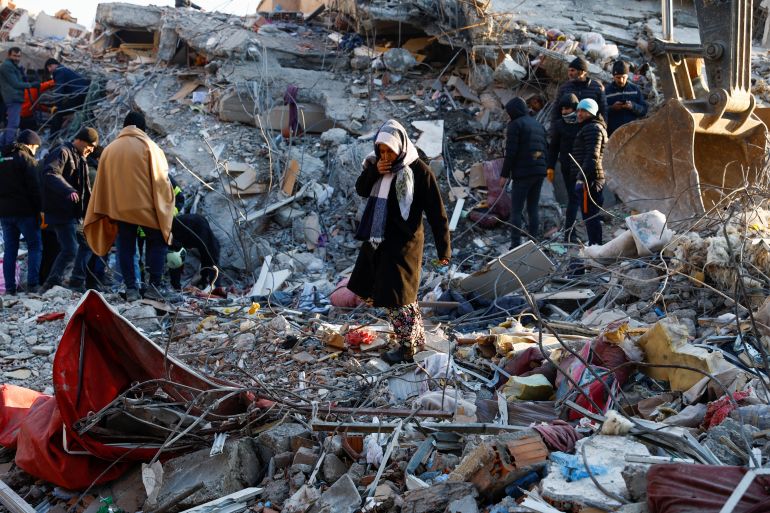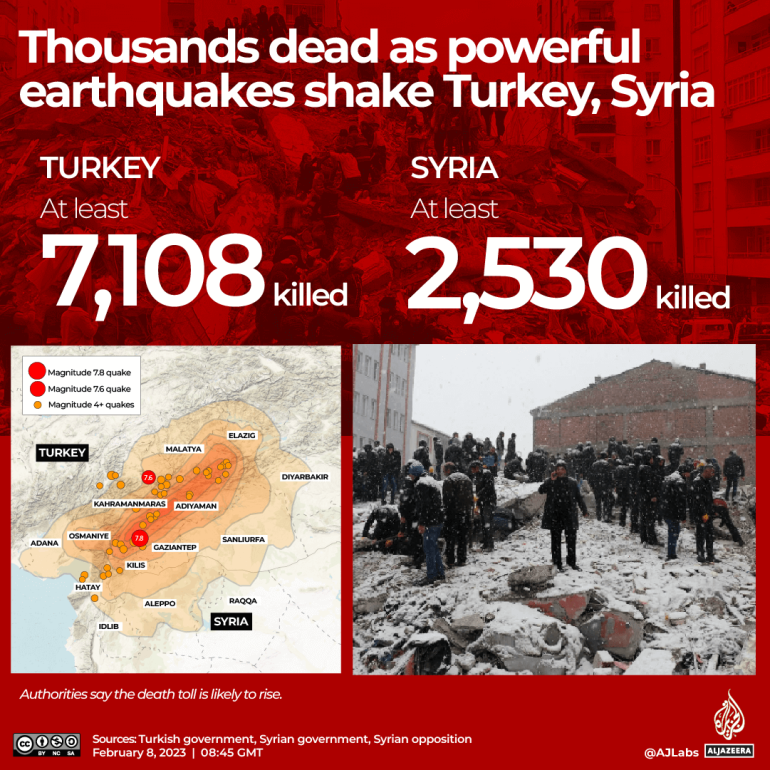Turkey-Syria earthquakes day three: What do we know so far?
Rescuers warn window is closing to find survivors under rubble as death toll passes 9,600.

Search and rescue operations in southern Turkey and northern Syria have entered their third day as the death toll surpassed 9,600 amid a warning from the World Health Organization that time was running out to save those still trapped under earthquake-toppled buildings.
Those efforts – buoyed by an array of international pledges to provide engineers, emergency responders and search dogs – have lasted for two days and two nights following Monday’s earthquakes, which began with an early magnitude 7.8 quake and has included several aftershocks, including a subsequent magnitude 7.6 earthquake.
Keep reading
list of 3 itemsVideos reveal extent of Turkey, Syria earthquake devastation
Syria longs for international aid amid earthquake devastation
Experts have warned the tremors could continue for weeks or even months, with survivors on Wednesday continuing to seek refuge from future quakes and the freezing temperatures in mosques, schools, bus shelters and homemade tents, often burning debris to stay alive.
Meanwhile, survivors in Turkey have expressed increased frustration over what they say has been a slow delivery of aid, while humanitarian groups warn rescue and aid operations in Syria, which remains engulfed in a 12-year-long civil war, have been hindered in both opposition and government-held areas.
What do we know about the casualties?
In Turkey at least 7,108 people have died, the country’s Disaster Management Authority said. More than 37,000 others were injured, the agency said. Turkish President Recep Tayyip Erdogan has declared a three-month state of emergency in the 10 hardest-hit provinces.
At least 1,280 people were killed in opposition-held northwest Syria, the White Helmet rescue service said, adding that “hundreds of families” remained trapped under rubble.
In areas under the Syrian government’s control, authorities said at least 1,250 have died.
The death toll was expected to continue to rise.
On Tuesday, UNICEF spokesperson James Elder told reporters at a briefing in Geneva “thousands of children” may have been killed in the disaster.
WHO chief Tedros Adhanom Ghebreyesus, meanwhile, warned that time was running out for the thousands injured and the untold number of those still believed to be trapped.

What do we know about the rescue operations?
Rescue operations across Turkey and Syria have been hampered by freezing rain and damage to arterial roadways and infrastructure.
Some residents of Turkey have expressed anger over the government’s response, with residents of hard-hit Gaziantep telling the AFP news agencies no rescue team arrived in the city in the first 12 hours after the disaster, and that those who did arrive ceased efforts early on Monday night.
For their part, Turkish officials have said that more than 8,000 people have been pulled from debris in the country and some 380,000 have taken refuge in government shelters or hotels.
Harrowing videos taken by those trapped, and accounts of several improbable rescues, have emerged.
In Jinderis, a small Syrian town near the Turkish border, a newborn infant survived after being pulled from the rubble of a collapsed building on Tuesday but her mother died, family members told The Associated Press news agency.
In Turkey, a 12-year-old girl in the province of Malatya was pulled from the rubble after 40 hours, while several children – including a four-year-old girl were rescued in Hatay province.
What’s happening in Syria?
Efforts to help Syria have been more complicated, with emergency responders in opposition-held areas reporting woefully inadequate equipment and manpower, with desperate rescuers at times resorting to using their hands to clear the rubble.
Aid groups have said already high hurdles to getting humanitarian support to opposition-held areas have been amplified by the disaster, with the only approved UN route from Turkey to northwest Syria – the Bab al-Hawa crossing – damaged.
On Tuesday, the United Nations said it was “exploring all avenues” to get supplies to rebel-held areas, including preparing a convoy to cross conflict lines within Syria. However, sending such a convoy would almost surely require a new agreement with Syrian President Bashar al-Assad’s government.
Western countries have also shown reluctance to send any aid directly through al-Assad’s government, which remains an international pariah and the subject of a raft of sanctions.
Once again, another miracle….. a child rescued after more than 40 hours of being trapped under the rubble of her house in the city of #Salqin in the countryside of #Idlib, #Syria yesterday, February 7.#SyriaEarthquake #earthquake pic.twitter.com/R7kRsNZFEG
— The White Helmets (@SyriaCivilDef) February 8, 2023
On Tuesday, the US said it was committed to helping residents “on both sides” of the Turkey-Syria border, but ruled out dealing directly with the Syrian government, while British foreign secretary James Cleverly said providing aid to Syria was “complicated” but London was “working through our UN partners on the ground”.
Meanwhile, rights observers have accused the Syrian government of playing politics with aid, after UN Ambassador Bassam Sabbagh told reporters that any support delivered to Syrian territory – government or rebel-held – must be done in coordination with the Syrian government.
What do we know about the quakes?
The first magnitude 7.8 tremor struck early on Monday morning, with the epicentre in Kahramanmaras, southeastern Turkey. The earthquake was about 18km (11 miles) under the surface, a relatively shallow depth that made it particularly destructive. It struck about 33km (20 miles) from Gaziantep, which is home to more than two million people.
The initial quake was about 50km (31 miles) from the border of northwest Syria, where approximately 1.7 million internally displaced Syrians live in a cluster of camps in areas controlled by opposition groups still fighting al-Assad’s forces.
More than 100 aftershocks followed, including a second quake with a magnitude of 7.6, causing damage in a vast area, including the cities of Hatay, Gaziantep, Sanliurfa and Diyarbakir in Turkey, and Idlib, Aleppo and Hama in Syria.
Geologically, Turkey predominantly sits on the Anatolian Plate, and straddles two major faults: the North Anatolian Fault, which runs between the Anatolian Plate and the Eurasian Plate to the north of Turkey’s land mass; and the East Anatolian Fault, which runs along the Arabian Plate to the southeast of Turkey’s territory.
The geological location makes Turkey one of the world’s most active earthquake zones.
What has the international response been?
Dozens of countries have deployed teams to Turkey or Syria.
Those include at least 19 European Union member countries that have offered assistance, with the European Commission offering to help Syrian victims by funding humanitarian organisations supervising search and rescue operations. The United Kingdom was also sending 76 search-and-rescue specialists with equipment and dogs.
The United States has said it is coordinating immediate assistance to Turkey, including teams to support search and rescue efforts.
The full scale of the double #earthquake disaster in Türkiye🇹🇷 & Syria🇸🇾 is still unknown, @UN humanitarians told the press in Geneva today, stressing the critical need to step up search & rescue efforts for victims and ensure that lifesaving aid reaches all those who need it ⬇️ pic.twitter.com/Xm80lo6IqL
— UN Geneva (@UNGeneva) February 7, 2023
Russian rescue teams from the Emergencies Ministry were sent to Syria, where Russian military deployed in that country already have sent 10 units comprising 300 people to help clear debris and search for survivors.
Eighty-two rescuers sent by the Chinese government have arrived in Adana, Turkey, including specialists in search and rescue as well as medical treatment. A South Korean military aircraft transporting a 118-person team of rescue and search workers and troops was headed to Turkey.
India was sending 100 search and rescue personnel from its Natural Disaster Response Force to Turkey, as well as specially trained dog squads and equipment for relief efforts.